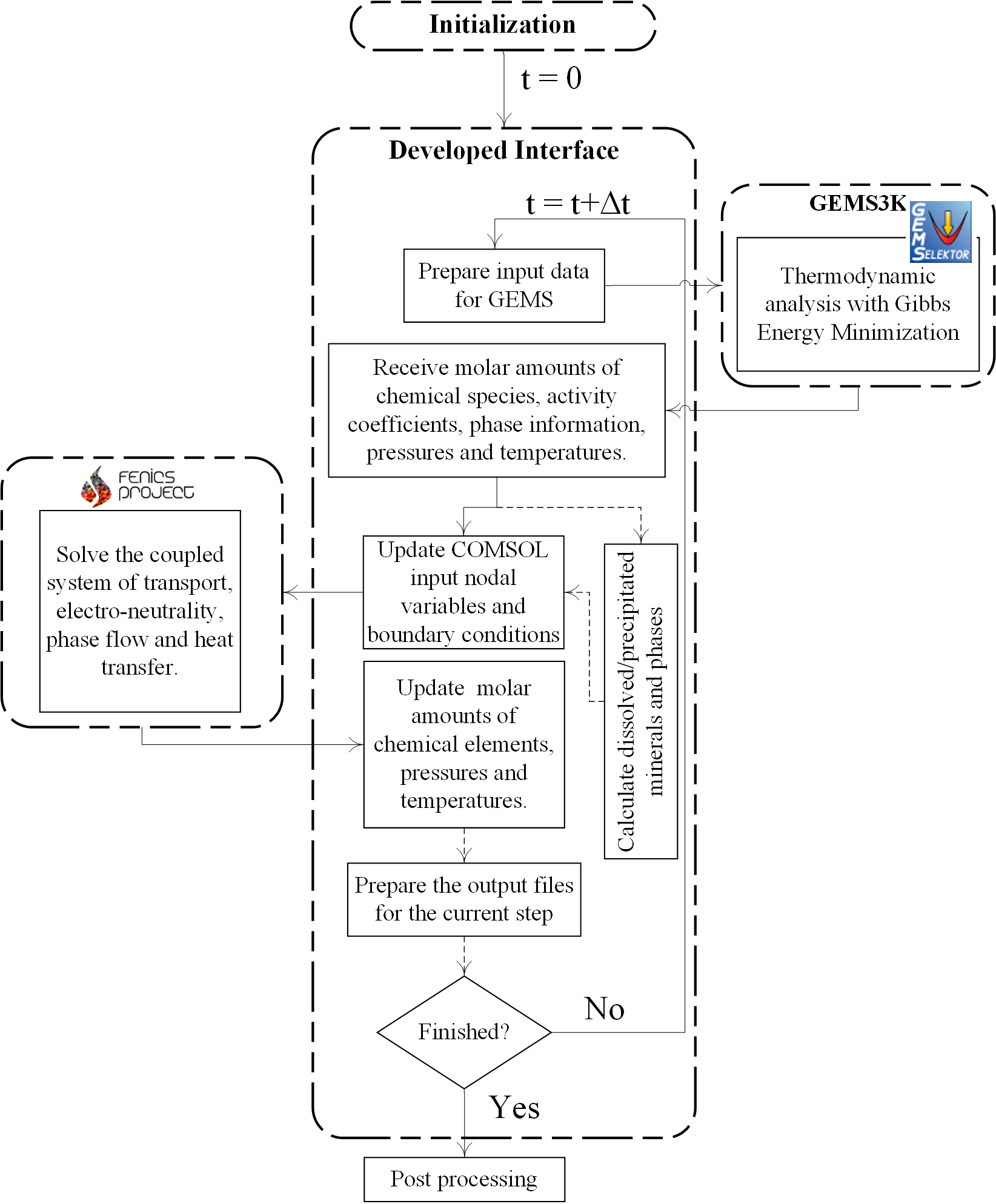
Reactive-Transport Modeling in Porous Media
Our goal in this project is to model multi-species multi-mechanism transport processes in porous media through finite element modeling that uses thermodynamic calculations to simulate complex reactions. Our current focus is cementitious materials and (geo)environmental applications, but the framework has also been used in other areas of materials science, biological and geo-chemical systems. We use GEMS-CEMDATA platform to conduct thermodynamic calculations. Finite element modeling is performed using multiple platforms, including open-source frameworks such as the FeNicS Project

Generic Corrosion Damage Modeling Frameworks For Traditional and Alternative Cementitous Matrices
In our past work, we used numerical techniques to develop practical corrosion modeling tools for reinforced concrete structures. These models were mainly FEM-based; however, we use also used these models as virtual test beds to conduct virtual experiments to develop practical closed-form equations. FEM-based models help us conduct fundamental studies to understand corrosion processes and develop new materials to mitigate corrosion-related issues in reinforced concrete structures.
The objective of our current research is to establish a fully coupled generic reaction-transport-corrosion-damage modeling framework for simulating corrosion-induced deterioration of reinforced concrete structural components. The unique feature of the study is the coupling of thermodynamic calculations to model reactions that can take place in concrete with transport, corrosion and damage phenomena. The formation of corrosion products and their distribution within the porous microstructure will be simulated in concrete with and without corrosion induced cracks. Generic nature of thermodynamic calculations to model reactions allows the simulation of corrosion-induced damage in structural components produced with traditional and alternative binders. These models are also important for existing structural systems since they help early identification of damage due to steel corrosion so that pre-emptive mitigation actions can be pursued and necessary repairs can be prioritized. This research requires a multi-disciplinary approach to make the modeling framework public so that researchers from these different backgrounds in the general engineering community can use, expand or apply it in related fields of investigation.
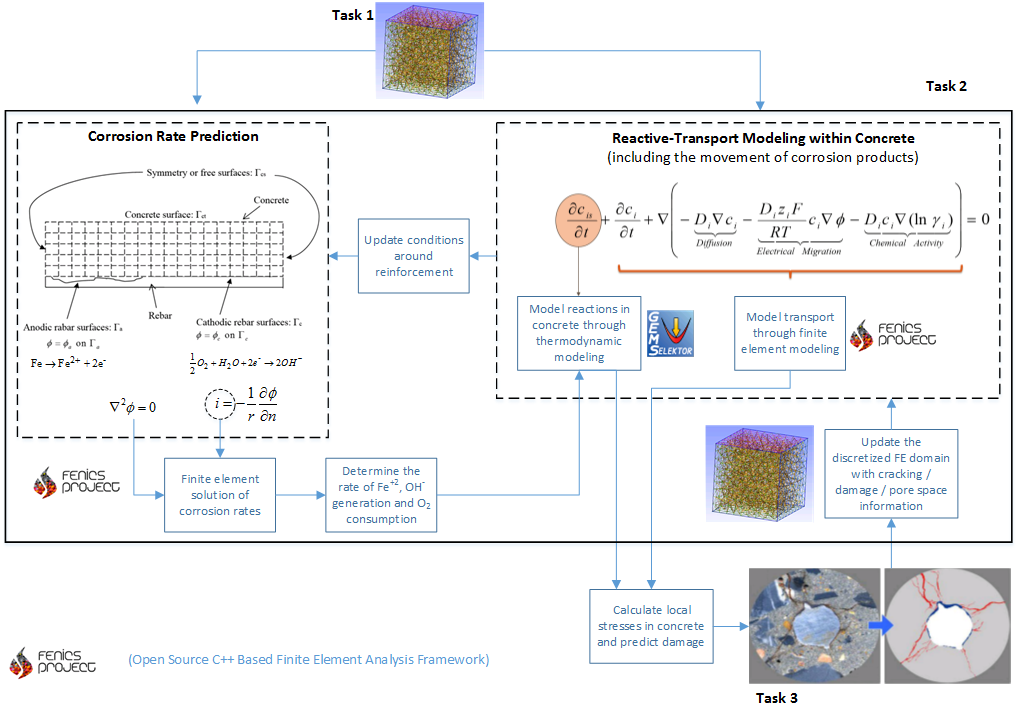
Passivity of Carbon Steel in Highly Alkaline Environments
Our goal is to study passivity and chloride-induced depassivation of carbon steel in highly alkaline environments such as concrete. We approach this problem from multiple angles using multi-disciplinary techniques that span multiple scales, ranging from nano to macro. The study involve electrochemical and corrosion techniques, surface science, and computational modeling.
We conducted a multi-scale investigation to understand the mechanisms of passivation and chloride-induced depassivation of steel in concrete. The study consisted of electrochemical experiments (EIS, PR, EN), microscopic examinations (SEM, FIB-TEM, selected area diffraction, convergent beam electron diffraction), numerical modeling (finite element and boundary element analyses), and spectroscopic studies (XPS, EDX, EELS).

Electrochemical and microscopic studies of the work showed that the composition of pore solution and surface conditions of steel affect the passivity and depassivation of carbon steel in concrete. Ions commonly found in concrete pore solutions have been observed to affect the passive film formed on carbon steel. Hence, even though concrete pore solutions are overwhelmingly composed of calcium hydroxide, results demonstrated the importance of these auxiliary ions during the formation of oxide films. It was also shown by microscopic and numerical studies that crevices on steel (e.g. between mill scale and steel) may become potential sites for depassivation.
In nano-scale, microscopic and spectroscopic studies indicated the formation of 5-10 nm-thick passive oxide films on carbon steel in simulated concrete pore solutions, and these films consisted layers separated with indistinct borders. Further knowledge was gained by studying the atomic structure of oxide films formed on carbon steel that are exposed to highly alkaline simulated concrete pore solutions using EELS. These investigations showed that oxide films close to the steel substrate were mainly composed of protective Fe(II) oxides while near the free surface the film consisted mostly of Fe(III) oxides.
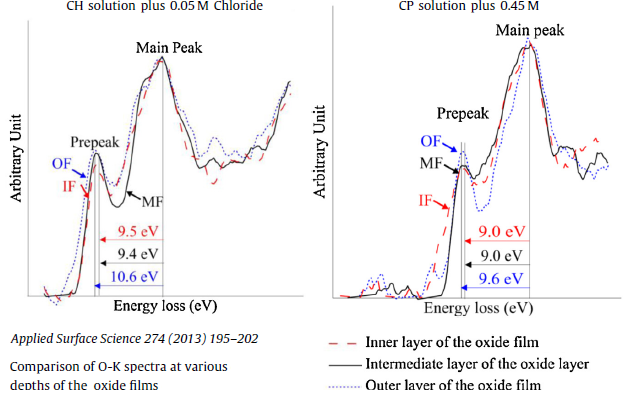
The addition of chloride to the concrete pore solution decreased the thickness of the oxide film and changed its stoichiometry such that near the film/substrate interface the Fe(II)/Fe(III) decreased. This multi-scale study re-defined our understanding of steel passivity and chloride-induced depassivation processes in concrete. The ongoing research that was initiated by this fundamental study is currently paving the way for the development of new corrosion resistant steels, corrosion inhibitors, and non-destructive testing and evaluation techniques.
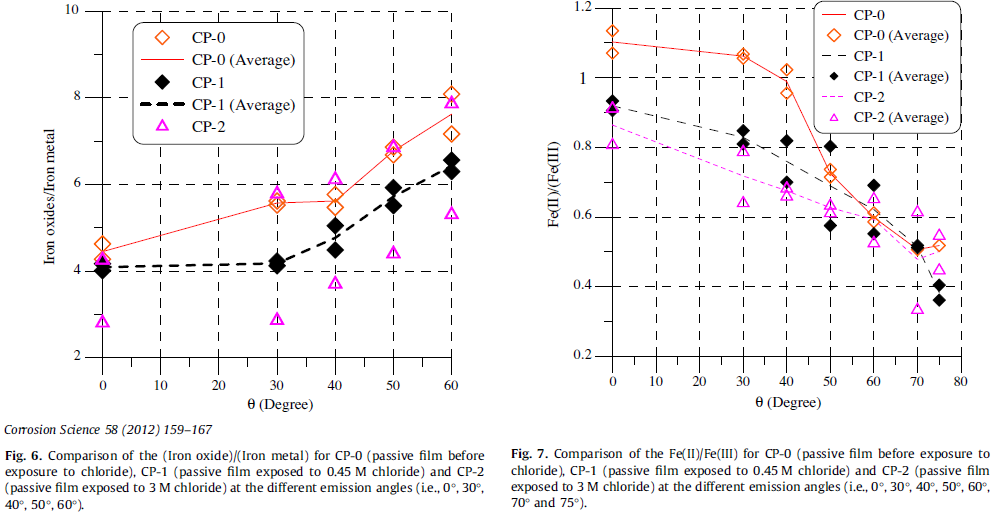
The multi-scale research framework summarized here allows us to study critical interdisciplinary problems in materials science and engineering using both bottom-up (nano-to-macro) and top-down (macro-to-nano) approaches. Analytical and spectroscopic observations supported by DFT and continuum simulations open new fronts for our research. One of these is the development of functional surfaces on metallic and non-metallic materials. Controled surface modifications in nano scale have the potential to revolutionize how materials interact with their environment and how they will deteriorate. For example, these surface modifications can lead to the development of highly durable materials that can withstand extreme exposure conditions. In the near future, we envision that our research will lead to the development of surface modified alloys that are inexpensive but highly durable against multiple forms of deterioration.
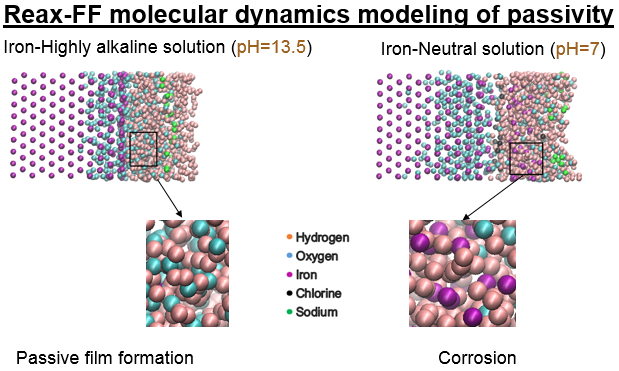
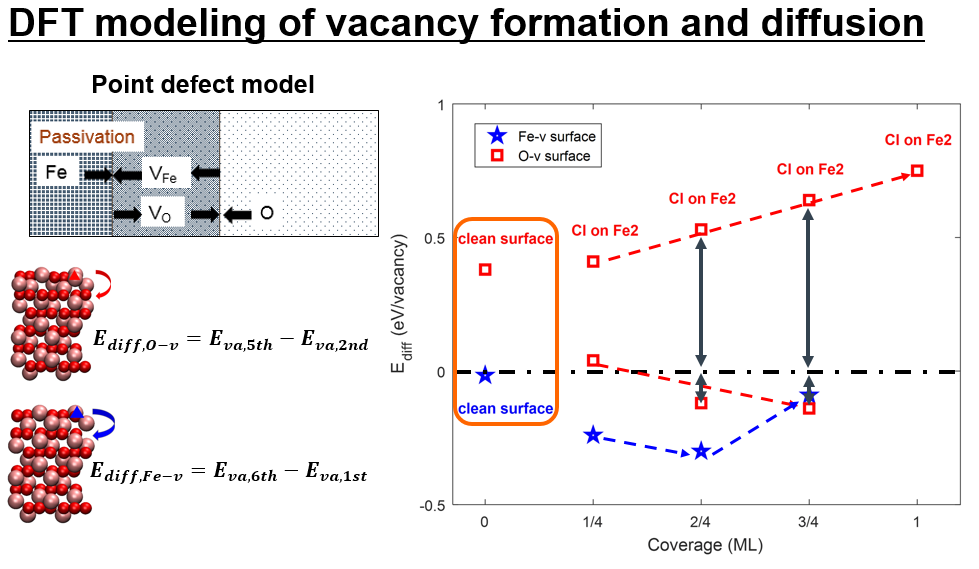
The Role of Interface Characteristics between Concrete and Reinforcement on the Passivity and Chloride-induced Corrosion Initiation
Our main objexctive in this project is to study the effect of imperfections on the steel-concrete interface on the chloride-induced depassivation of reinforcement in concrete structures. These imperfections involve (1) mill scale, (2) defective coatings on rebar, (3) elongated cracks along the interface, (4) pores, and (4) construction defects (e.g. settlement gaps under rebar). We use electrochemical methods, microscopic methods, thermodynamic modeling, and continuum simulations to study the related phenomena.
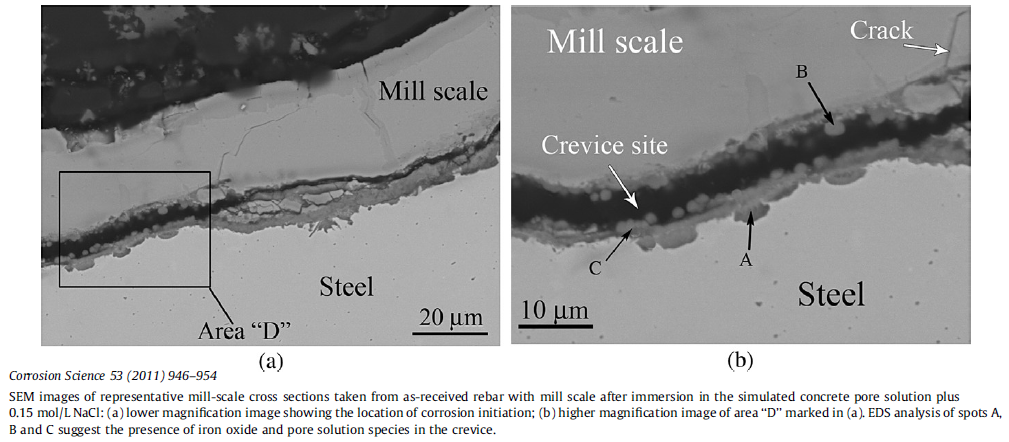
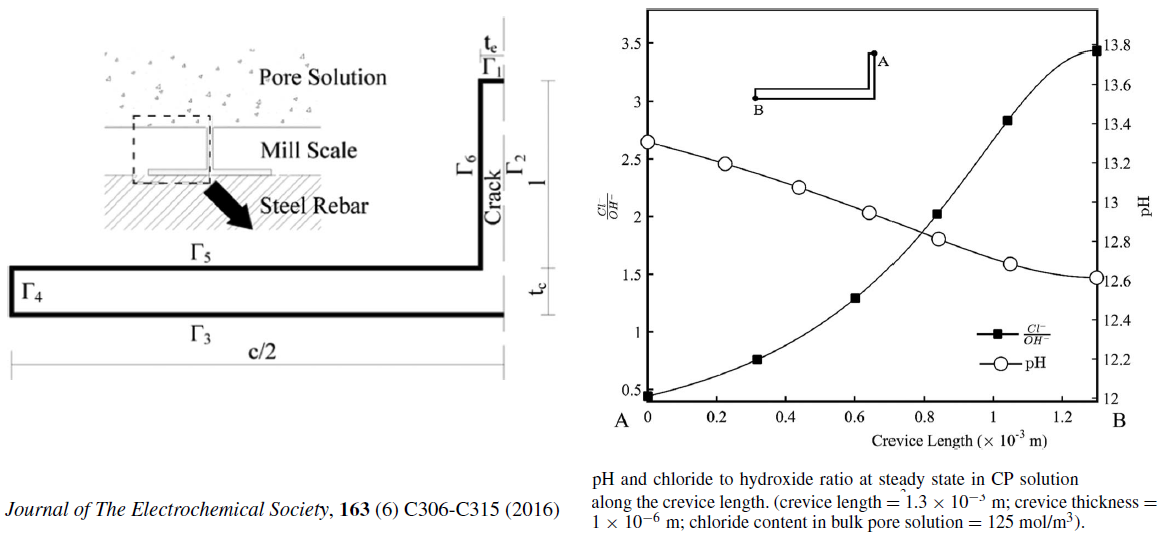
Thermodynamic Studies on Cementitious Materials
We use thermodynamic modeling principles to study various problems involving cementitions materials. We currently use Gibbs Free Energy Minimization technique to make thermodynamic calculations using the GEMS-CEMDATA framework. When required, we couple thermodynamic calculations with finite element analysis to model transport of species in cementitious matrices and to obtain bulk properties such as electrical resistivity. The problems we currently study involve (1) calciumoxychloirde (CaOxy) formation in concrete, (2) porosity predictions in OPC and blended systems, (3) pore solution composition and conductivity predictions in OPC and blended systems, (4) electrical resistivity and formation factor of concrete, (5) reactivity of supplementary cementitious materials, and (6) chloride binding.
Non-destructive Testing of Reinforced Concrete Structures
In this project, we develop leading-edge model-assisted non-destructive testing protocols for monitoring concrete deterioration and reinforcement corrosion. We strive to develop integrated numerical and sensory tools for infrastructure owners and operators so that they can better evaluate the state of their assets and make informed decisions on their future. These tools help engineers manage infrastructure by allowing them to schedule maintenance, rehabilitation and replacement operations more efficiently and accurately so that their assets will be resilient against extreme conditions imposed by multiple sources of hazard.
Microbially Induced Concrete Deterioration
Our goal is to study microbially induced concrete deterioration and its mitigation strategies through the use of biofilms, coatings and inhibitors.